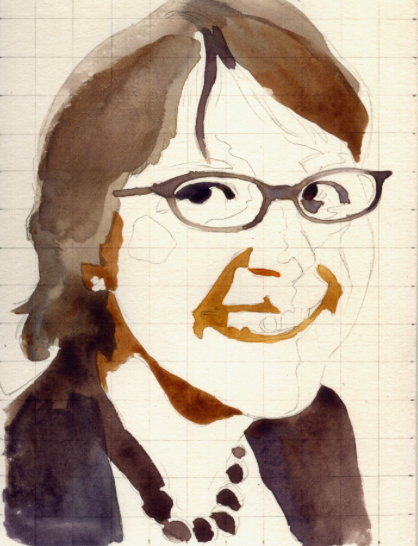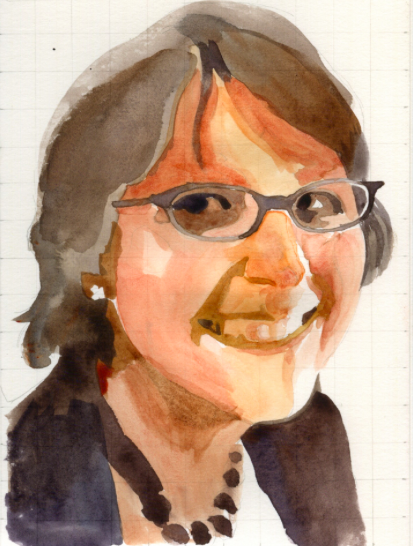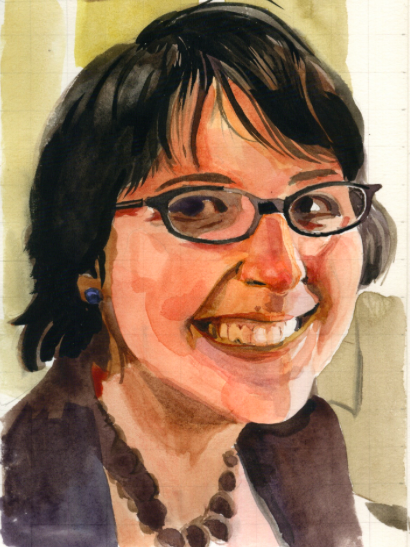We all know painting a portrait is a challenge, but the idea of painting a portrait in watercolor can be downright intimidating. Watercolor is notorious for being unforgiving, so much so that many folks would never attempt a portrait in this tricky medium.
But if you do it right, painting a portrait in watercolor can yield amazing results! Here are some tips and tricks to get you started.
To start painting anything in watercolor requires a little planning and patience. Whether you’re painting from a photograph or from life, it helps to establish your composition first. Knowing how much of your subject you will be painting will make things much easier down the road. I’ve cropped this photo down from a “landscape” format to include just my subject’s head and shoulders, and to match the dimensions of my paper.

If you are painting from a photograph, it can be useful to transfer your image using a grid.
Step 1:
Draw out the subject lightly in a hard pencil, such as a 4H. Pay close attention to the dark and light shapes in the head and face rather than the finer details. You’re going to be working from general to specific and the details will come later, so use a big round or flat brush, not a small rigger or liner for these washes.

Step 2:
Block in the darkest values first using dark washes. Avoid using black, but instead, combine Burnt Umber and dark blue for anything exceptionally dark. It helps to squint your eyes while looking at your subject to help isolate the dark values. Don’t worry that these washes aren’t as dark as they could be; you will have a chance to darken them more later.

Tip: It is important to let each layer of washes dry completely before laying down any new wash that might come in contact with a previous wash. This is especially important when laying down light washes, as they can pull in dark pigment from an earlier wash and become muddy.
Step 3:
Using lighter washes, block in the lighter values of the face, leaving the lightest areas untouched. Avoid oversaturated colors by using plenty of water in your washes, and tone down your warm washes with a tiny bit of a cool pigment, such as a dark blue, to keep them from becoming too intense.

Tip: You can “pull up” any areas that may have gotten too dark by using a clean wet brush. Dab the brush against the dark area once it has dried to push and pick up any excess pigment, or to blend a new wash with a previous one without leaving a line or “tide mark.”
Step 4:
After laying down your lighter washes, it’s easier to see where your first washes can be darker. Using a higher ratio of pigment to water, go back and re-establish the darkest values; in this case the hair and glasses. For hair, pay attention to where the highlights are located. You can often showcase these just by leaving a previous lighter wash visible while blocking in darker values. You don’t need to paint every strand; the value difference will show the viewer that the hair is shiny. Work into the details of the face with a smaller round brush.

Step 5:
Lay in washes for the background. Here I’ve chosen a muted yellow-green as a complement to the warm tones in the face. The background wash can also serve to set off the highlights in a face, in this case the lower right, where the cheek had previously been hard to differentiate from the white background.

Since this is a watercolor, leaving things loose and gestural if preferable to over-working. Let the watercolor do what it wants to do, and you should be able to conquer the watercolor portrait like a pro! What do you find most challenging about watercolor portraits? To learn more about painting watercolor portraits, be sure to enroll in Portraits in Watercolor with Matt Rota.
I can't wait to try to this. Thank you!
My daughter wants to take watercolor classes this winter. I thought it was interesting how you can transfer a photograph into a grid. I will suggest this method for her.
Have only just found your website, but having read your comments I find myself both encouraged and anxious to “have a go”. Let’s hope I can use your help/encouragement/suggestions and improve my previous attempts. I particularly like the idea of a light grid, rather than actual tracing, makes it more “personal” somehow. Will let you know how things progress. El Tel.
Your Comment here...Very good
it is very helpful to the first beginners